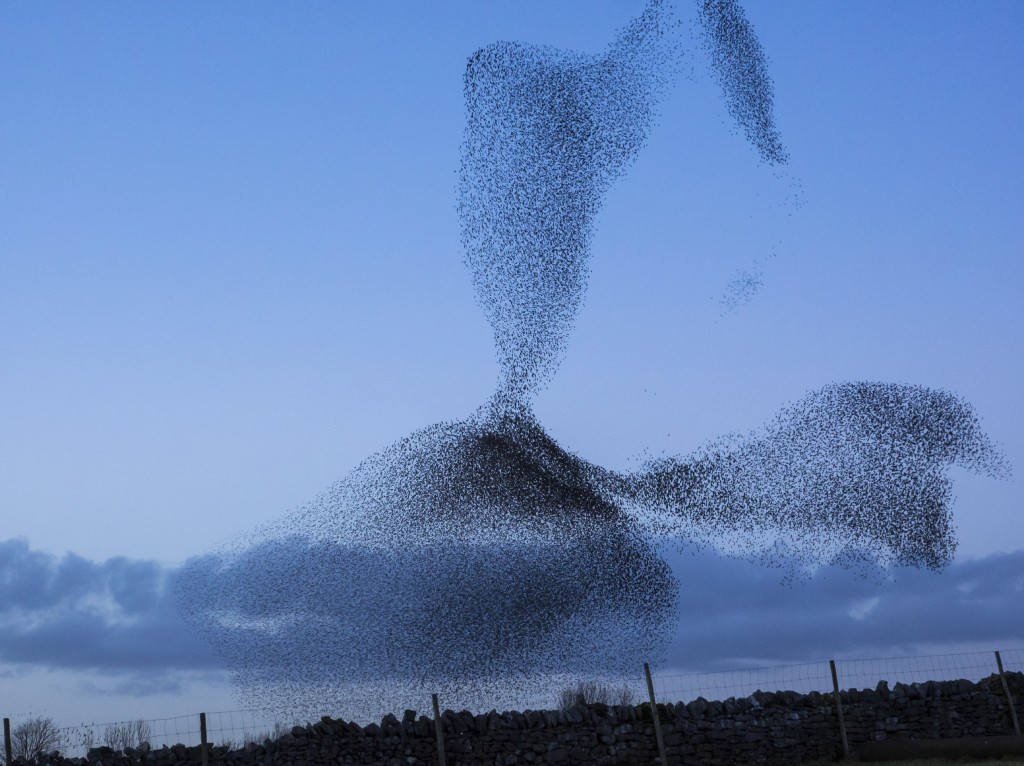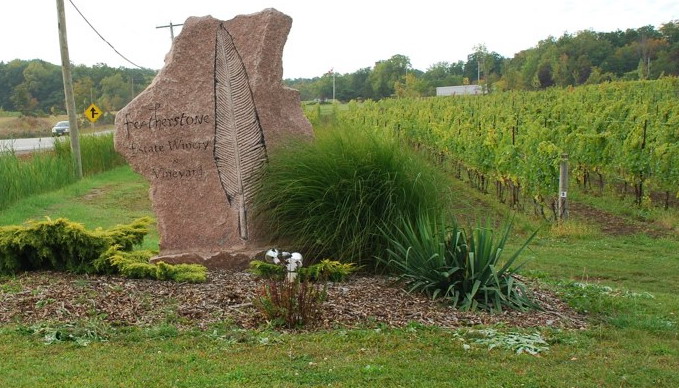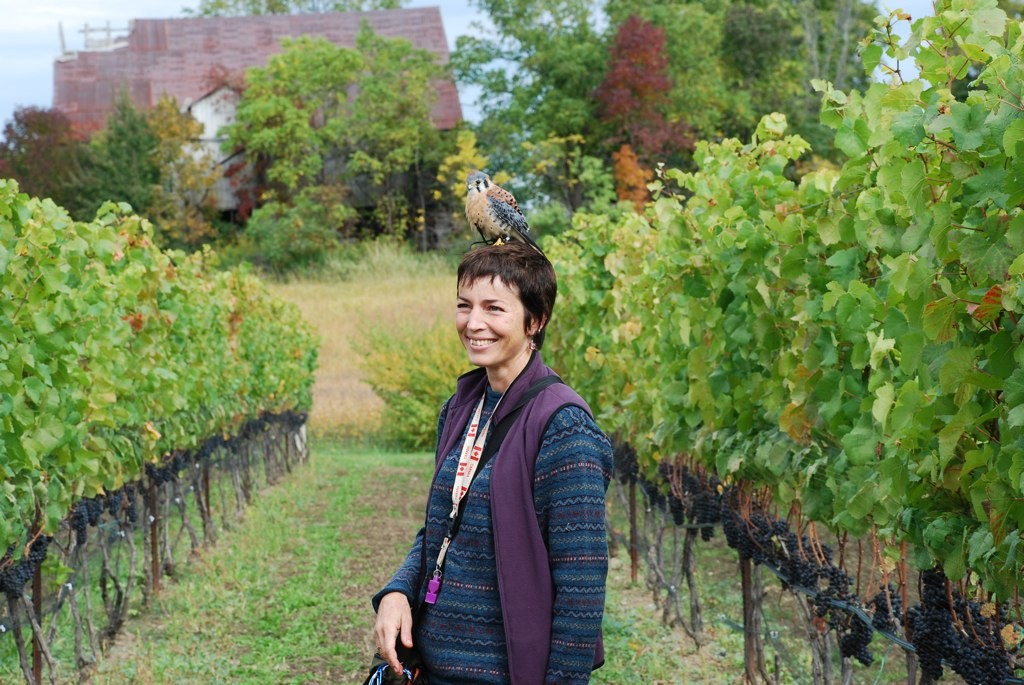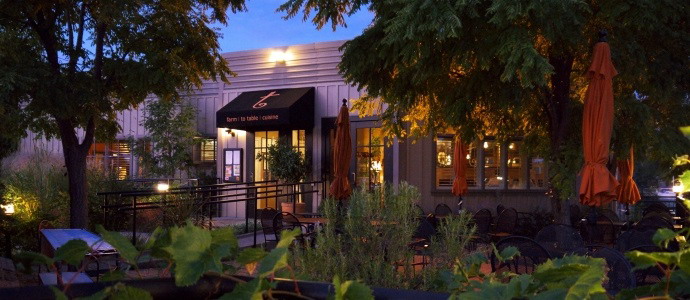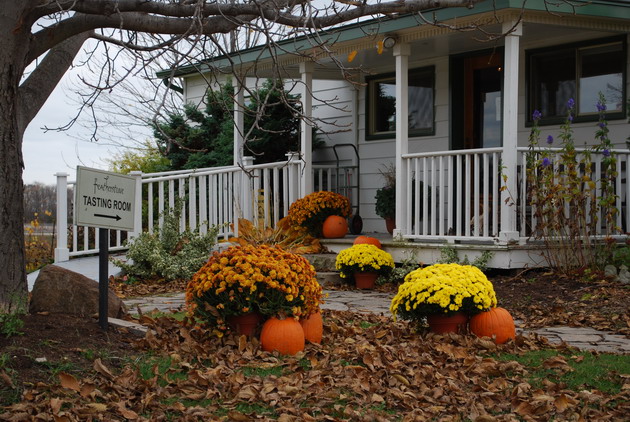Approaching Featherstone Winery, I can see a pepper storm of starlings flying over the vineyard.
Husband and wife team David Johnson and Louise Engel have a passion for all things fowl. Before they became winemakers, they ran a gourmet poultry shop, selling tasty birds, from turkeys to quails. (That’s where the “feather comes from; the “stone” is the Niagara Escarpment.)
However, those hungry starlings that feed on the ripening grapes are no friends of David and Louise. That’s why I’m going to meet their latest avian associate today, a Harris Hawk that’s trained to hunt those pesky birds.
In 1989, David started making wine as a hobby and won awards in amateur competitions. He began to spend less time at the shop and more in the cellar, eventually becoming certified with the Amateur Winemakers of Ontario judging program.
In 1999, he and Louise sold the poultry shop and bought a farm house surrounded by 23 acres of vines on the Niagara Escarpment. The vineyard’s lovely contours and rolling hills dip down to a small creek running between them. To the east is a rich stand of pine trees and to the west, looms the rugged rock face of the escarpment.
Louise Engel could be Peter Pan’s sister, with her pixie haircut, impish grin and compact frame that would be perfect for flying. I ask her about the harvest.
“We just managed to pull this one out of the moat,” she says. “After such a wet summer, we really needed those 26 days of sunshine. Could be a sleeper year, like 2008.”
David comes out of the barn, taking off his heavy gloves to shake my hand. He looks more like an English professor than a winemaker, with steel-framed glasses and a serious expression. Louise tells him she’s taking me to see the lambs—vital team members in maintaining the Featherstone vineyards.
David got the idea when he worked at Sileni Winery in New Zealand where many wineries use sheep to nibble down the grass and unwanted vine leaves. (“This may have something to do with the fact that there are 35 million sheep and 3 million people in the country.”)
For larger wineries, the savings add up, especially since there isn’t a ready source of cheap farm labor there. One New Zealand vintner, Peter Yealands, calculated that without sheep, he’d have to have seven tractors mowing his two thousand miles of vineyards a dozen times a year—at a cost of about $35,000.
“When I got back, we tried a few ‘lambmowers’ here,” David says. The experiment was such a success that now about forty lambs arrive every July. Once they finish with the grass, they start eating the tender, young grape leaves that grow low on the vines. In the fruiting zone, where the grapes will eventually grow, the leaves must be thinned to give the bunches more sun exposure to ripen and better ventilation to avoid mould.
“Sheep are ideally suited to the job,” David observes. “They can’t reach high enough to damage the vine and they’re not interested in eating the unripe grapes. They graze 24/7, don’t complain about the weather and don’t ask for days off. They also cultivate the soil, not just with their natural fertilizer of digested nutrient-rich grass, but also with their hooves that till the earth. That means less chemical fertilizer. Their environmental hoof-print is quite small.”

There’s even a vineyard tool called a “sheep’s foot” for when the woolly kind isn’t available. They eliminate the need for tractor mowing, which compacts the soil and reduces the biodiversity of the earth’s natural micro-organisms.
Raising vineyard-friendly lambs is now a niche market for some farmers, such as Cindy Deserioux, from whom David and Louise buy their lambs. Louise takes me to visit her postcard-charming farmhouse, where two dozen adult ewes run away to the pasture when they see us coming. Only the breeding ram, twice as large as the others, stands his ground and stares us down. “He’s from Alberta and thinks he’s hot stuff,” Cindy comments.
The sheep are a low-slung breed descended from an ancient British mountain stock called Olde English Babydoll Southdowns. They’re rugged, short-legged creatures that only grow two feet high at the shoulder, the perfect range for thinning vine leaves.
Most are bred to be born in February and ready for work in July. Right now, in October, there are only two out-of-season lambs frolicking far out in the field, one black and one white.

These babydoll lambs are so damn cute, like bow-legged granny wigs. - Natalie MacLean Click to tweet
“Come here girls!” Cindy calls in her sweet, motherly voice. If I were a lamb, I’d follow her anywhere. We move back and eventually they come bounding to the barn where she feeds them.
At Featherstone, the lambs stay until the end of August, just before harvest. Where do they go then? (“Do you hear the lambs, Clarice?”) David and Louise sell them to restaurants where they finish their happy lives on plates matched with local wines. (Hey, it’s the circle of life.) That’s why Louise never names any of the sheep: “I’m never here when the truck comes for them.”
Every fall, Treadwell’s Restaurant in the nearby town of St. Catherine’s hosts a “Featherstone Lamb Dinner.” The menu celebrates the animals from snout to tail, featuring dishes like pickled tongue with lobster knuckles and celery root remoulade paired with the Featherstone Blacksheep Riesling and then pan-seared liver with caramelized shallots and brown butter, matched with the winery’s Canadian Oak Chardonnay.
This is followed by a savoury “odds and ends” (don’t ask) shepherd’s pie with whipped mashed potatoes and parsley bread crumbs with the Cabernet Franc; stout-braised shank ravioli with confit shoulder and autumn ratatouille with the Gamay Noir and a saddle of roasted lamb and garlic dauphinoise potato in truffled pan juices with the Onyx Cabernet Franc Merlot. To finish, there’s a selection of Ontario sheep’s milk cheeses and homemade preserves with the Late Harvest Cabernet Franc.
Back at the winery, Louise fills me in on the biggest problem she and other vintners face in this region: bird predation. It’s estimated that North American farmers lose about $1.6 billion a year from birds and other crop 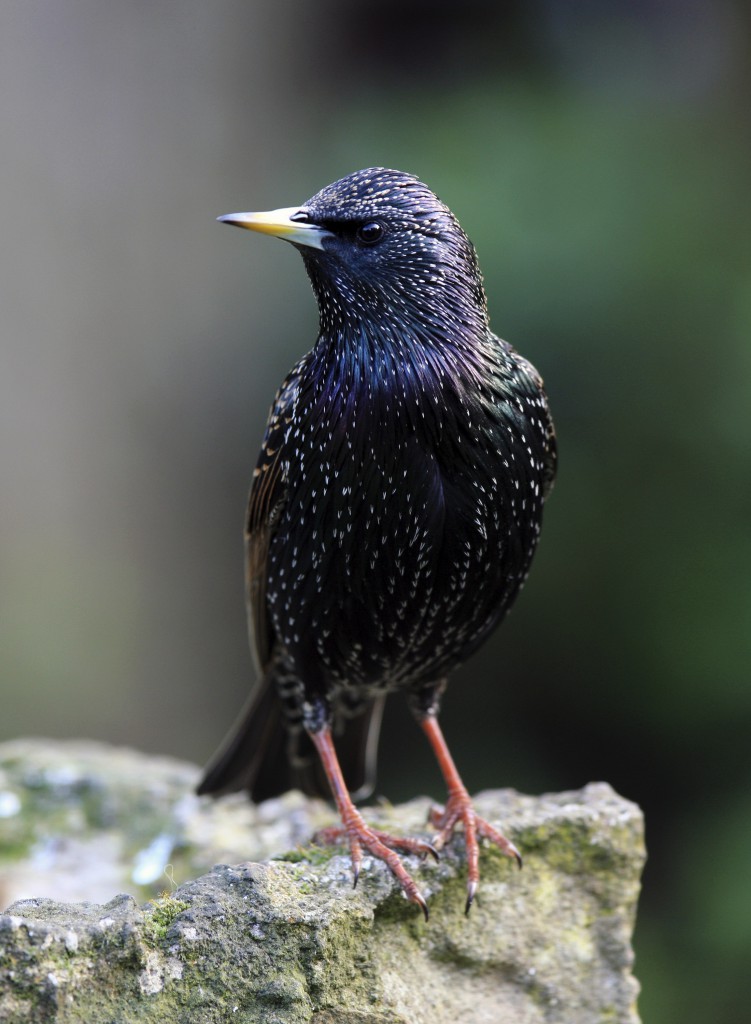 predators. The Niagara grape growers association estimates that starlings destroy $15-million or 5 percent of wine crops a year.
predators. The Niagara grape growers association estimates that starlings destroy $15-million or 5 percent of wine crops a year.
A flock of birds can strip clean several tons of grapes in a couple days, with a vintner’s entire year’s work sliding down those beaky little gullets. The fruit they don’t eat they peck at and leave to rot on the vine.
Louise dislikes starlings the most. They’re not even a native species, but an import from England. In the 1870s, some idiot who was enraptured with Shakespeare decided to collect all the songbirds mentioned in the sonnets and released them in New York City’s Central Park. The starlings fared best as opportunistic feeders and prolific breeders, and muscled their way into habitats across North America.
“They have no redeeming features,” Louise says, her personal enmity showing. “They are parasitic rats with wings.” She remembers Thanksgiving 1999 with particular venom because “the friggin’ starlings ate all our crop. That was when I became determined to do something about it.”
Click on the arrow to play the video above. You can expand this video to full screen by clicking the square in the bottom right corner.
Modern technology has given vintners an arsenal of weapons to fight the avian menace. Among the tools are advanced computerized versions of the bird bangers that explode at random intervals so that the birds don’t get used to a pattern.
Other wineries use “screamers,” modified starting pistols that shoot firecrackers and bio-sonic technology known as “squawk boxes,” which broadcast distressed bird calls.
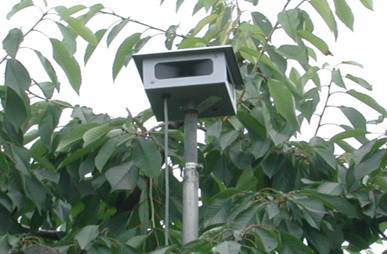
Then there are “terror eyes,” balloons painted with the eyes of predators, foil-glittering Mylar ribbons, reflective windmills, flapping windsocks and automatic guns that spray the vineyard with pebble pellets. Some vintners (or their teenaged offspring) ride all-terrain vehicles through the rows, dragging cans.
The problem with all of these approaches is that the birds quickly adjust to most of the attempts used to scare them. For instance, they learn exactly how far the automatic pellet spray reaches and stay just outside its range like an enemy outside the castle wall taunting the besieged.
The most effective way to protect vineyards from birds is to drape the whole property in nets. That works, though it’s an expensive solution and they need to be replaced every five years. The nets also make tending the vines more time-consuming.
They can also cause other headaches: after some birds became accidentally ensnared in one local winemaker’s nets, the provincial ministry of natural resources fined him for “trapping birds out of season.” (Fortunately, the charges were dropped.) Most wineries use nets just for icewine grapes, which are more vulnerable to birds because they must stay on the vines until December or January. The precious (and pricey) dessert nectar they produce justifies the expense.
However, Louise is about to demonstrate the one starling-repellent that really works. She introduces me to Amadeus, a Harris hawk, with gorgeously sleek saffron plumage. She puts on a big leather glove and gently lifts him out of his wire pen in the yard. Louise is a licensed falconer who owns several hawks, though she’s not required to have a license to own Amadeus (he’s not an indigenous species). But she chose to get the qualification, enrolling in a two-year study program, in order to better understand him.

“Owning a hawk is a substantial, year-round commitment,” Louise says. “It’s on par with owning and training a horse. They’re not pets.”
We start walking through the vineyard, Amadeus flitting ahead of us, from one trellis post to the next. I haven’t been paying much attention to the background birdsong, but I notice that as we stroll along with Amadeus, the vineyard suddenly goes eerily quiet, as though every living thing has frozen into silence at the sight of a predator.
Hawks are trained entirely by the reward of food. Punishment is ineffective: unlike dogs, raptors couldn’t care less about pleasing their owners and won’t respond to a gruff tone of voice.
What about those little thieves that are his prey? Louise explains that the flocks that damage vineyards include both resident and migratory birds. The migrating birds start arriving in mid-August en route to their winter homes in corn and soybean fields in the southern United States.
For those grackles, sparrows, crows, waxwings and orioles, the Niagara vineyards make a lovely roadside diner. To encourage them to keep moving, Featherstone uses four propane bird bangers and a battery-powered squawk box, which sounds to me like a screeching bird hell. The bangers’ only drawback is their effect on some tourists, who are convinced that the winery must be on prime hunting grounds and ask eagerly what’s in season. (On the plus side, Louise quips, it’s great cover if you ever want to get rid of someone during the fall.)
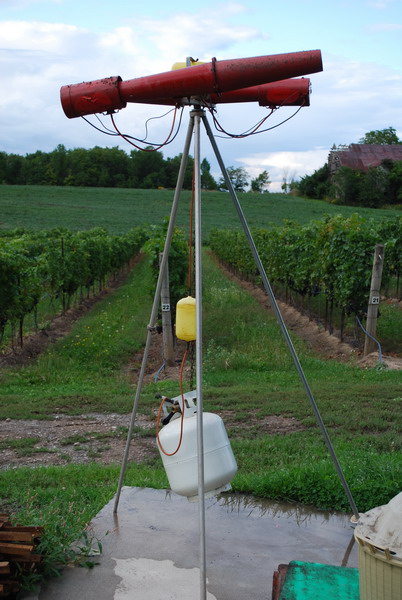
Niagara’s year-round resident birds are mostly robins, starlings and mourning doves that live in the woods bordering the farm’s fields. Since they become accustomed to the bird bangers, Louise tries to prevent them from settling in, since they’re much harder to remove once they establish themselves.
That’s why Amadeus is such a powerful “there goes the neighbourhood” deterrent: his mere presence in the 23-acre vineyard discourages them from settling in. Even if the hawk flies for just a few hours each day, he can establish dominance over the vineyard. However, when she doesn’t fly him for a few days because of the weather or other projects, she notices that the bird activity increases again.
Some birds, such as robins, starlings and mourning doves, are protected by federal law, so Louise needs a permit to hunt them even on her own property. She also needs a hunting license because a falcon is considered a weapon and must be registered like a firearm. Louise took the same course designed for hunters who shoot moose or deer with rifles. Hunting with falcons is considered a blood sport, which may be why only 10 percent of licensed falconers are women.
Louise tells me that when Amadeus does catch a songbird, he carries it to a tree branch where he’s hidden from other predators who might steal his lunch. He’ll “mantle” his food, covering it with his wings while he eats. He plucks off the large feathers, then eats the whole bird—bones, cartilage, small feathers—in about twenty minutes. After eating, his crop (throat) swells visibly and about twelve hours later, he casts up the indigestible feathers and bones.

Although he could snack on a starling a day, it’s more natural for raptors to gorge three to four times a week and not eat in between. Captive raptors have their diets monitored vigilantly. Managing the bird’s weight is critical: if he’s too heavy, he won’t bother hunting; if he’s too light, he gets weak and unhealthy. Amadeus is weighed daily and the result is recorded along with his food intake and weather. (When it’s cold, he needs more food.) In the summer, his ideal flying weight is 22 ounces: if he gets just one ounce heavier than that, he loses interest in hunting, akin to the de-motivational principle such as too-high unemployment benefits.
Amadeus is part of David and Louise’s commitment to both sustainable and organic farming. “We’re not tofu-and-granola people, but this approach makes sense,” Louise says. “I read a warning on a bag of synthetic fertilizer that said, “Do not enter the vineyard for seven days after applying.” Well, we live here!” Instead, David spreads mushroom compost on the vineyard to help aerate the soil and improve its moisture retention during dry periods. This compost helps control weeds as well, and reduces the need for herbicides. David plants cover crops of rye grass and radish to help control erosion and to enrich the clay with organic matter.
The couple also tries to minimize the winery’s impact on the environment, using all of their resources efficiently, such as water and energy, and to use recycled and non-polluting materials wherever possible. David stopped using insecticides in 1999. Instead, like Malivoire, he releases ladybugs and lacewings into the vineyard to control aphids. He releases pheromones to disrupt the mating cycle of the grape berry moth. By not using insecticides, the farm fosters beneficial insects.
While she’s telling me this, Louise leads me into the tasting room. David joins us and pours us a glass of their Black Sheep Riesling, a medium-bodied wine with mouth-watering notes of melon, pear, peach, honeysuckle, lime and tangerine zest. It would marry beautifully with spiced Thai cuisine, grilled salmon and vegetarian dishes.
Next we try their chardonnay. Featherstone was one of the first wineries to use Canadian oak barrels to age wine. The trees are grown, harvested, air-dried and milled near Ancaster, Ontario. Then the wood slats are shipped to California for coopers to make the barrels. It’s the same species as American oak, but with a tighter grain that supposedly imparts less flavor. Using Canadian oak on Canadian wines may make sense conceptually, but I find that the wood imparts a funky aroma, with an odd fennel aftertaste. Maybe it’s just a matter of working out the toasting and cooperage methods.
We move on to several vintages of their pinot noir, my favourite wines. These bright young things wake up your mouth and enliven your senses. Pleasingly tart cherries dance across your palate, followed by a dazzling weave of truffles, rose petals and spices.
Next we try their cabernet franc, which dispels the misperception that Niagara can’t make this wine without it tasting of bell pepper. Their rich version is loaded with ripe dark berries and mocha notes. A full-bodied, balanced flavor gives way to dried tobacco leaves and blackberries on the finish. This would be perfect with lamb and mint sauce—or perhaps with liver and fava beans.
As our wing-and-hoof visit draws to a close, I almost expect to hear the theme music from Born Free to swell behind us. However, the hawks and sheep are not some sort of stealth PR strategy: they’re an integral part of the couple’s approach to winemaking. Growing grapes can be a monoculture, so they like having the animals around to make the winery feel like a working farm.
“We want to get wine off a pedestal,” Louise says. “That starts with our visitors seeing the vineyard for what it is: a grape farm.”


